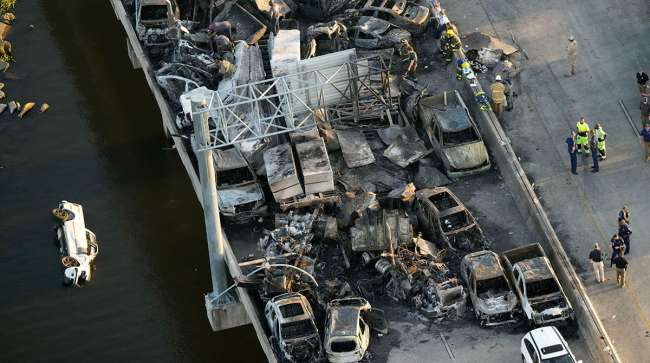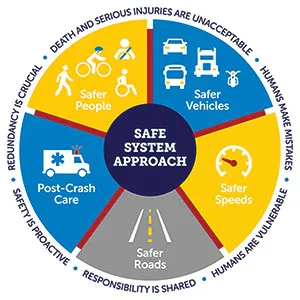Senior Reporter
Transportation Agencies Face Safety Challenges, Report Says

[Stay on top of transportation news: Get TTNews in your inbox.]
Although transportation regulators since 2020 have been making moderate strides in reducing the number of fatalities on U.S. roadways, a new Department of Transportation Inspector General report has concluded that DOT agencies — including the Federal Motor Carrier Safety Administration — face a number of challenges in 2024 to meet their ambitious safety goals.
“To address large truck and bus fatalities, the Federal Motor Carrier Safety Administration’s challenges include revising and implementing its Safety Measurement System; maintaining data quality on motor carriers’ safety performance; and enforcing compliance with federal regulations, including commercial driver medical certifications, license disqualifications, and timely compliance reviews,” the DOT IG said in a “top management challenges” report released earlier this month.
DOT’s 2023 National Roadway Safety Strategy Progress Report includes the concrete steps DOT has taken to systematically address the national crisis of roadway fatalities and serious injuries, the DOT IG report said.
“As required by law, we report annually on the DOT’s most significant challenges to meeting its mission,” the report said. “We considered several criteria to identify DOT’s top management challenges for fiscal year 2024, including impact on safety, documented vulnerabilities, large dollar implications, and the department’s ability to effect change.”
For example, the IG report noted that the estimated fatality rate for the first half of 2023 was 1.24 per 100 million vehicle miles traveled, compared to the estimated 1.31 for the first half of 2022. The second quarter of 2023 also represents the fifth straight projected quarterly decline in fatalities.
“This comes after seven consecutive quarters of year-to-year increases in fatalities, beginning with the third quarter of 2020,” the report said.
However, the report also noted that, despite massive doses of transportation funding sourced from the November 2021 bipartisan infrastructure law, challenges remain.
“In light of the nearly $660 billion in funding authorized by the Infrastructure Investment and Jobs Act to bolster the nation’s transportation infrastructure, our report also discusses IIJA’s impact on each of the management challenge areas we identified,” it said.
The key DOT challenges include identifying root causes and implementing safety programs to reduce fatalities and verifying and enforcing railroad, transit, pipeline, and hazardous materials safety compliance. The IG stressed that implementation of these priorities may involve trade-offs as stakeholders address surface transportation infrastructure goals.

“Preferences for how to secure certain supply chains or to contribute to American economic leadership may have unintended outcomes, such as higher costs,” the report said. “Because the challenges of these objectives are immense, the department must find ways to evaluate trade-offs and balance priorities and goals that maximize efficiency and achieve long-term effectiveness.”
With just the initial funding from bipartisan infrastructure legislation, DOT has begun repairing 4,600 bridges and 75,000 miles of roads and is well on its way to meeting President Joe Biden’s goal of building a national network of 500,000 public electric vehicle charging stations by 2030.
But the funding is not just going to roads and bridges — the department is also making investments to modernize the nation’s rail and transit systems, ports and airports. The IG report noted that the Federal Railroad Administration dedicates substantial resources to responding to major events like the East Palestine train derailment and hazardous materials release in February. That agency, the report noted, “remains challenged to use data-driven, risk-based oversight to effectively address incidents and perform routine rail safety oversight functions.”
Per the report, FRA via its newly created Office of Research, Data and Innovation is supporting these efforts by developing risk-based modeling and analysis tools to focus its safety oversight on high-risk areas.
Check out Transport Topics' updated Top 50 list of the largest freight transportation companies in the world and explore how these companies are re-evaluating their supply chains. Tune in above or by going to RoadSigns.ttnews.com.
DOT is also committed to achieving transparency, the IG report noted. To meet this goal, DOT surface agencies are called up to provide reliable, timely and accessible data on program implementation, funding use and progress toward meeting priorities and goals.
However, the department faces challenges here.
“For example, we found weaknesses in the Federal Transit Administration’s tracking and reporting of Hurricane Sandy funds through the end of 2020. These weaknesses reduced transparency for internal users, decision-makers and the public into FTA’s use of the funds,” according to the report.
The IG added, “DOT has committed to a wide range of priorities and goals related to surface transportation, including strengthening American leadership in clean cars and trucks, improving mobility choices, modernizing transportation infrastructure, addressing climate change, advancing equity in its transportation investments, and accomplishing economic objectives.”
Want more news? Listen to today's daily briefing below or go here for more info:





